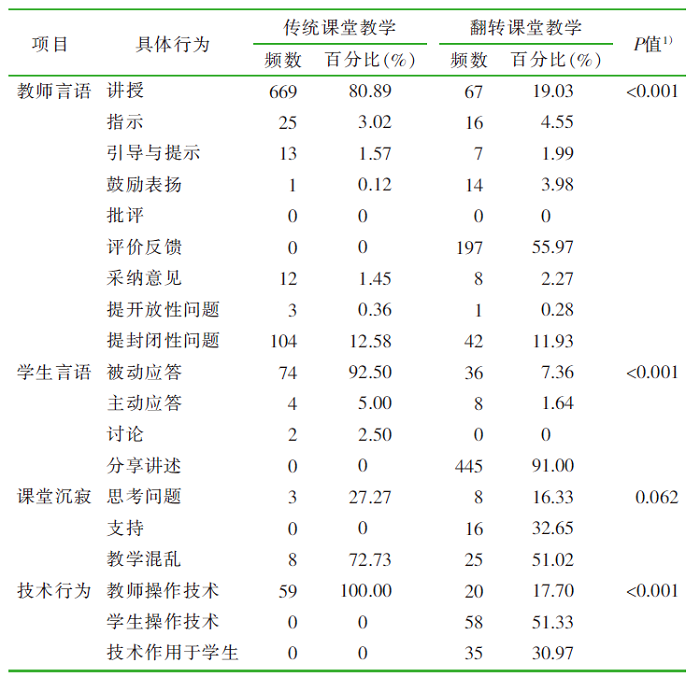| [1] |
高星, 章雅青, 王琳, 等. 基于小规模限制性在线课程的翻转课堂在护理管理学教学中的应用[J]. 中华护理教育, 2021, 18(7):613-617.
|
|
Gao X, Zhang YQ, Wang L, et al. Application of flipped classroom based on small private online course in Nursing Management[J]. Chin J Nurs Educ, 2021, 18(7):613-617.
|
| [2] |
彭宇, 沙丽艳, 董建俐, 等. 基于SPOC的混合式教学在护理专业教学中应用效果的系统评价[J]. 中华护理教育, 2021, 18(5):446-451.
|
|
Peng Y, Sha LY, Dong JL, et al. The systematic review of the effects of mixed teaching based on small private online course (SPOC) in nursing education[J]. Chin J Nurs Educ, 2021, 18(5):446-451.
|
| [3] |
Flanders N. Intent,action and feedback:a preparation for teaching[J]. Journal of Teacher Education, 1963:14.
|
| [4] |
顾小清, 王炜. 支持教师专业发展的课堂分析技术新探索[J]. 中国电化教育, 2004(7):18-21.
|
|
Gu XQ, Wang W. New exploration of classroom analysis technology to support teacher professional development[J]. China Educ Technol, 2004(7):18-21.
|
| [5] |
杨平展, 刘娟文, 罗平. 关于教学行为分类系统VICS的讨论[J]. 教师, 2009(6):3-4.
|
|
Yang PZ, Liu JW, Luo P. Discussion on the teaching behavior classification system VICS[J]. Teacher, 2009(6):3-4.
|
| [6] |
傅德荣, 章慧敏, 刘清堂. 教育信息处理[M]. 2版. 北京: 北京师范大学出版社, 2011.
|
| [7] |
Cohen EG, Flanders NA. Analyzing teaching behavior[J]. Am Educ Res J, 1971, 8(3):589.
|
| [8] |
黄斌, 杨馨宇, 李晓艳. 改进型课堂教学行为云模型的应用研究:以传统课堂和翻转课堂的个案分析为例[J]. 课程教学研究, 2021(1):70-77.
|
|
Huang B, Yang XY, Li XY. Research on the application of im-proved classroom teaching behavior cloud model:a case study of traditional classroom and flipped classroom[J]. J Curric Instr, 2021(1):70-77.
|
| [9] |
闻娟, 刘晓燕, 刘勤勇. 智能互联背景下教师课堂教学评价分析[J]. 上海教育评估研究, 2021, 10(6):37-41.
|
|
Wen J, Liu XY, Liu QY. Analysis of teachers’ classroom teaching evaluation based on intelligent Internet[J]. Shanghai J Educ Eval, 2021, 10(6):37-41.
|
| [10] |
郭艳侠, 梁珣, 张敏. 翻转课堂结合对分课堂教学模式在老年护理学教学中的应用[J]. 护理学杂志, 2020, 35(15):72-74.
|
|
Guo YX, Liang X, Zhang M. Application of flipped class combined with presentation-assimilation-discussion teaching mode in the course of Geriatric Nursing[J]. J Nurs Sci, 2020, 35(15):72-74.
|
| [11] |
邝孔秀, 刘芳, 劳金晶. 小学数学教师课堂提问的现状与改进策略[J]. 课程教材教法, 2020, 40(10):77-81.
|
|
Kuang KX, Liu F, Lao JJ. The status quo and improvement strategy of classroom questioning of elementary school mathematics teachers[J]. Curric Teach Mater Method, 2020, 40(10):77-81.
|
| [12] |
Archila PA, Molina J, Danies G, et al. Using the controversy over human race to introduce students to the identification and the evaluation of arguments[J]. Sci Educ, 2021:1-32.
|
| [13] |
Dehghanzadeh S, Jafaraghaee F. Comparing the effects of traditional lecture and flipped classroom on nursing students’ critical thinking disposition:a quasi-experimental study[J]. Nurse Educ Today, 2018, 71:151-156.
doi: 10.1016/j.nedt.2018.09.027
|
| [14] |
Field JC, Zhang ED, Milke V, et al. Patterns of verbal interaction and student satisfaction within a clinical setting:a video-enhanced observational study[J]. Eur J Dent Educ, 2019, 23(1):e45-e52.
|
| [15] |
Deshpande S, Ritzenthaler D, Sun A, et al. A unique flipped classroom approach shows promising results in physician assistant education[J]. Med Teach, 2020, 42(3):285-290.
doi: 10.1080/0142159X.2019.1679360
pmid: 31633996
|
| [16] |
阮娟娟, 邵菡清, 曹阳, 等. 基于虚拟仿真技术的翻转课堂教学在儿科护生临床带教中的应用[J]. 中国高等医学教育, 2021(8):45-46.
|
| [17] |
王觅, 文欣远, 李宁宁, 等. 大单元教学视角下基于LSA的同步课堂师生交互行为研究[J]. 电化教育研究, 2020, 41(8):74-81.
|




